Brookestaines
On this page, you find all documents, package deals, and flashcards offered by seller brookestaines.
- 20
- 0
- 0
Community
- Followers
- Following
20 items
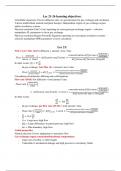
Understanding Gas Exchange and Circulatory Systems: Lecture 21 Overview
This document encapsulates the core concepts discussed in Lecture 21, focusing on organisms' gas exchange and circulatory systems. It elaborates on Fick’s Law and the Hagen-Poiseuille Equation, explaining how physical constraints influence the evolution of gas exchange organs and circulatory systems. Furthermore, it delves into the mathematical formulations of gas flux and flow rate, emphasizing the crucial role of concentration gradients and pressure differentials in gas exchange. The docume...
- Class notes
- • 3 pages •
This document encapsulates the core concepts discussed in Lecture 21, focusing on organisms' gas exchange and circulatory systems. It elaborates on Fick’s Law and the Hagen-Poiseuille Equation, explaining how physical constraints influence the evolution of gas exchange organs and circulatory systems. Furthermore, it delves into the mathematical formulations of gas flux and flow rate, emphasizing the crucial role of concentration gradients and pressure differentials in gas exchange. The docume...
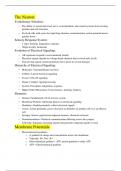
Comprehensive Lecture Notes on Neurons and Electrical Signaling
These lecture notes provide a detailed exploration of neurons, electrical signaling, and the evolution of nervous systems. The document covers various aspects, including the evolutionary solutions that led to the development of neurons, sensory response systems, and the evolution of electrical signaling. It delves into the elements of neurons, membrane potentials, action potentials, and synaptic transmission. Additionally, the notes discuss the techniques used to measure membrane potential, the ...
- Class notes
- • 8 pages •
These lecture notes provide a detailed exploration of neurons, electrical signaling, and the evolution of nervous systems. The document covers various aspects, including the evolutionary solutions that led to the development of neurons, sensory response systems, and the evolution of electrical signaling. It delves into the elements of neurons, membrane potentials, action potentials, and synaptic transmission. Additionally, the notes discuss the techniques used to measure membrane potential, the ...

Lecture Notes on Induced Mutation, DNA Repair, and Genetic Regulation
These lecture notes cover Topic 8, focusing on induced mutations, DNA repair mechanisms, and genetic regulation in prokaryotic and eukaryotic organisms. The notes provide an overview of various types of mutations, their phenotypic effects, and the consequences of mutations on functional sequences. Additionally, the document discusses DNA repair mechanisms such as homologous recombination repair (HRR) and nonhomologous end joining (NHEJ), as well as chromosomal variations and transposable element...
- Class notes
- • 3 pages •
These lecture notes cover Topic 8, focusing on induced mutations, DNA repair mechanisms, and genetic regulation in prokaryotic and eukaryotic organisms. The notes provide an overview of various types of mutations, their phenotypic effects, and the consequences of mutations on functional sequences. Additionally, the document discusses DNA repair mechanisms such as homologous recombination repair (HRR) and nonhomologous end joining (NHEJ), as well as chromosomal variations and transposable element...

Lecture Notes on RNA-Based Gene Regulation: Mechanisms and Impacts on Gene Expression
These lecture notes cover Topic 12, focusing on RNA-based regulation and its effects on gene expression. The notes provide a comprehensive overview of various RNA regulatory mechanisms in both prokaryotes and eukaryotes, including transcription, translation, and chromatin structure changes. Key topics include mRNA secondary structures, riboswitches, antisense RNA, RNA interference (RNAi), and long non-coding RNAs (lncRNAs). Additionally, the notes explore specific examples and experimental appli...
- Class notes
- • 5 pages •
These lecture notes cover Topic 12, focusing on RNA-based regulation and its effects on gene expression. The notes provide a comprehensive overview of various RNA regulatory mechanisms in both prokaryotes and eukaryotes, including transcription, translation, and chromatin structure changes. Key topics include mRNA secondary structures, riboswitches, antisense RNA, RNA interference (RNAi), and long non-coding RNAs (lncRNAs). Additionally, the notes explore specific examples and experimental appli...
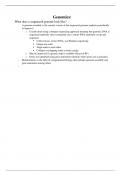
Lecture Notes on Genomics: Understanding Sequenced Genomes
These lecture notes cover Topic 13, focusing on the fundamentals of genomics. The notes explain the genome sequencing, from collecting tissue samples and extracting DNA to sequencing using Illumina technology. They detail the steps involved in aligning reads, forming contigs, and improving genome assemblies with genetic maps. Additionally, they explore gene annotation and the role of bioinformatics in genome assembly and annotation, providing a comprehensive overview of what a sequenced genome l...
- Class notes
- • 1 pages •
These lecture notes cover Topic 13, focusing on the fundamentals of genomics. The notes explain the genome sequencing, from collecting tissue samples and extracting DNA to sequencing using Illumina technology. They detail the steps involved in aligning reads, forming contigs, and improving genome assemblies with genetic maps. Additionally, they explore gene annotation and the role of bioinformatics in genome assembly and annotation, providing a comprehensive overview of what a sequenced genome l...
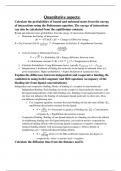
Quantitative Aspects of Molecular Biology: Final Exam Study Guide
This study guide is designed for students preparing for their final exam on the quantitative aspects of molecular biology. It covers key calculations and concepts such as determining probabilities of bound and unbound states using the Boltzmann equation, understanding independent and cooperative binding through Langmuir and Hill equations, calculating diffusion times, and using Nernst and Goldman equations for membrane potentials. The guide aims to equip students with the mathematical tools and ...
- Class notes
- • 2 pages •
This study guide is designed for students preparing for their final exam on the quantitative aspects of molecular biology. It covers key calculations and concepts such as determining probabilities of bound and unbound states using the Boltzmann equation, understanding independent and cooperative binding through Langmuir and Hill equations, calculating diffusion times, and using Nernst and Goldman equations for membrane potentials. The guide aims to equip students with the mathematical tools and ...
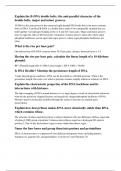
Central Dogma: Final Exam Study Guide
This study guide is intended for students preparing for their final exam on the Central Dogma of molecular biology. It provides a comprehensive review of key concepts, including the structure and properties of B-DNA, DNA replication mechanisms, DNA repair processes, and the role of various enzymes. The guide also covers the characteristics of genetic elements, chromosomal structures, and the implications of mobile genetic elements. It aims to consolidate essential knowledge to thoroughly underst...
- Class notes
- • 6 pages •
This study guide is intended for students preparing for their final exam on the Central Dogma of molecular biology. It provides a comprehensive review of key concepts, including the structure and properties of B-DNA, DNA replication mechanisms, DNA repair processes, and the role of various enzymes. The guide also covers the characteristics of genetic elements, chromosomal structures, and the implications of mobile genetic elements. It aims to consolidate essential knowledge to thoroughly underst...
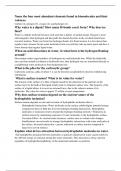
Chemistry of Life: Final Exam Study Guide
This study guide is designed to aid students in preparing for their final exam in Chemistry of Life. It covers fundamental concepts including the elements most abundant in biomolecules and their valences, properties of water, acid dissociation in water, and the pKa of carboxylic groups. Additionally, it delves into surface tension, hydrophobic interactions, and the parameters that measure hydrophobicity. The guide also explores the types of interactions holding molecules together, the nature of ...
- Class notes
- • 2 pages •
This study guide is designed to aid students in preparing for their final exam in Chemistry of Life. It covers fundamental concepts including the elements most abundant in biomolecules and their valences, properties of water, acid dissociation in water, and the pKa of carboxylic groups. Additionally, it delves into surface tension, hydrophobic interactions, and the parameters that measure hydrophobicity. The guide also explores the types of interactions holding molecules together, the nature of ...
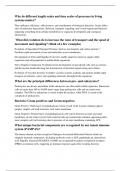
Evolutionary Biology: Final Exam Study Guide
This study guide is designed to help students prepare for their final exam in Evolutionary Biology. It covers critical concepts such as the significance of different length and time scales in biological processes, evolutionary adaptations for increased efficiency in transport and signaling, distinctions between prokaryotic and eukaryotic organisms, bacterial structures and their interactions with the immune system, and the bioenergetic processes in bacteria. Additionally, it explores the endosym...
- Class notes
- • 5 pages •
This study guide is designed to help students prepare for their final exam in Evolutionary Biology. It covers critical concepts such as the significance of different length and time scales in biological processes, evolutionary adaptations for increased efficiency in transport and signaling, distinctions between prokaryotic and eukaryotic organisms, bacterial structures and their interactions with the immune system, and the bioenergetic processes in bacteria. Additionally, it explores the endosym...
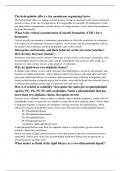
Membrane Structure and Function: Key Concepts for the Final Exam
This study guide provides an in-depth overview of membrane biology, focusing on the hydrophobic effect as a key organizing factor, critical micelle concentration, the behavior of detergents and surfactants, and the structural features of lipids and proteins in membranes. It covers essential topics such as the composition and dynamics of lipid bilayers, the distribution of water and major zones within bilayers, and the unique adaptations of extremophiles. Additionally, it explains the significanc...
- Class notes
- • 4 pages •
This study guide provides an in-depth overview of membrane biology, focusing on the hydrophobic effect as a key organizing factor, critical micelle concentration, the behavior of detergents and surfactants, and the structural features of lipids and proteins in membranes. It covers essential topics such as the composition and dynamics of lipid bilayers, the distribution of water and major zones within bilayers, and the unique adaptations of extremophiles. Additionally, it explains the significanc...
